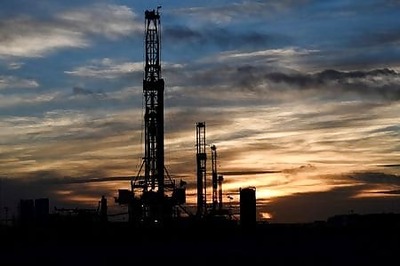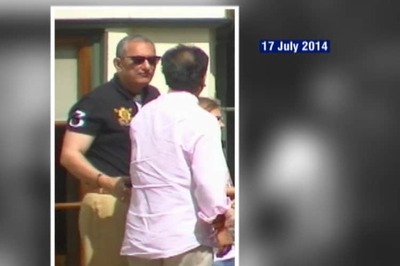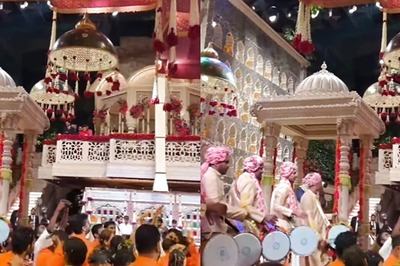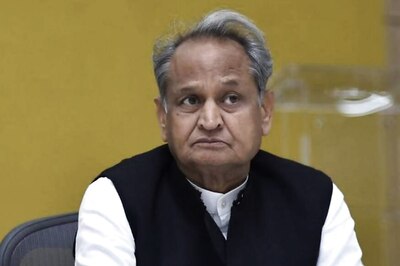
views
The Save Aarey campaign has restarted in Maharashtra after the MVA government is ousted from power and replaced by the BJP-Shiv Sena (Eknath Shinde) combine. The new government gave permission to build a Metro car shed at Aarey on the day the new chief minister and deputy chief minister were sworn in. The MVA government had stalled all infrastructure projects, including Mumbai Metro, after it came into power.
The leading constituent of the MVA government and former ally of the BJP, the Shiv Sena, had supported the Save Aarey movement even when it was in power with the BJP. Aditya Thackarey led the agitation against Mumbai Metro’s car shed at Aarey. The campaign to stall Mumbai Metro car shed is covered with a mask of environmental activism. The very first argument presented by the anti-Mumbai Metro car shed lobby is that the project will destroy the green lungs of the Maximum City. This is on the premise of their second claim that Aarey is part of Sanjay Gandhi National Park. This column endeavours to present facts and separate it from propaganda forwarded by the faux environmentalist lobby that is against development.
Mumbai was the financial capital of India since the pre-Independence era. When India got Independence, Mumbai, then called Bombay, had a population of around 3 million people. The transportation infrastructure of the city was built by the British in the pre-Independence era, with local trains starting on 1 February 1865, followed by BEST Bus Services starting on 15 July 1926. Since then the Maximum City has grown leaps and bounds to touch a population of around 18 million people. However, the public transport infrastructure hasn’t expanded to handle this kind of exponential increase in population.
It is obvious that roads cannot be expanded beyond limit and there is no alternative to local trains. While India’s Asian peers like Hong Kong, Singapore, Beijing, Shanghai, and Dubai started metro services in 1979, 1987, 1969, 1993, and 2009, respectively, Mumbai tiptoed in the world of Metro very late in 2014, with Line 1 operating from Ghatkopar to Versova connecting the Eastern and the Western corridors. However, the South to the North line was yet to be planned.
Mumbai is the city that has grown from the South to the North. Nearly all traffic moves from the North to the South in the morning when people are going to work, and vice versa when people are returning home. In such a situation, there is an extremely urgent need for an alternative North-South corridor that can connect residential areas with commercial districts of Mumbai. This is where Line 3 of the Mumbai Metro was conceptualised to reduce the load on the existing and overburdened Eastern and Western local train lines.
This 33.5 km long underground metro starts from Colaba and culminates at SEEPZ. This metro line connects six major business districts in South Mumbai’s Old Central Business District, including Cuffe Parade, Nariman Point, and Ballard Estate, the Alternate Business District of Lower Parel, Mumbai’s New Central Business District of Bandra Kurla Complex, and the Peripheral Business Districts of Goregaon and SEEPZ, two Major Outstation Terminuses i.e. Chhatrapati Shivaji Maharaj Terminus in the Central Line or Eastern Corridor and Mumbai Central in the Western Line or Corridor and two Airport Terminals.
Suburban trains operating in the city in both the corridors are overcrowded, ferrying around 5,000 passengers against its designed capacity of 1,750. Western local line ferries more than 3.5 million people daily and Central line ferries more than 7.6 million passengers daily. This is a daily traffic of more than 11 million passengers. It is envisioned that Mumbai Metro Line 3 can reduce the load on suburban local lines by around 15 percent. It will also become a catalyst to shift car commuters to metro’s air-conditioned coaches and thereby reduce around 4.5 lakhs vehicles on road per day. This would translate in a saving of around 2.5 lakh liters of fuel per day which would be a saving of more than Rs 550 crore per annum.
The travel time from Cuffe Parade to the airport will be cut down to half from current around 100 minutes once Mumbai Metro Line 3 is operational. The government has announced that trains of Mumbai Metro Line 3 will have a special feature of 40 percent regenerative energy generated during braking for captive use. Considering all these factors, the estimated reduction of emission is expected to be around 1 lakh ton CO2 emissions per annum in the beginning. This reduction in emissions is equivalent to the impact from two crore fully grown trees.
It is obvious that Mumbai doesn’t have space to either expand roads to handle the traffic of 4.5 lakh cars or plant 2 crore trees. Hence, Mumbai Metro Line 3 becomes the only viable alternative, on all fronts — economical, passenger convenience, and ecological.
However, the “Greens” or the “Environmental Activists” have hijacked the project with their regular alibi of harm to the environment. In the process, they have spread misinformation by presenting Aarey as a forest and confusing people with the propaganda that Aarey is part of Sanjay Gandhi National Park, which is not the fact. The scare created by these environmental activists is that the green lungs of the city will be destroyed. Here, some information needs to be presented to separate facts from propaganda.
The Sanjay Gandhi National Park is spread over 11,687 hectares. The Aarey Colony — about 1,287 hectares — is separate from the Sanjay Gandhi National Park. In its order dated 4 October 2019, the Bombay High Court specifically stated that Aarey Colony is not a forest, and also not part of Sanjay Gandhi National Park. The same order rejected the petition seeking to declare the Aarey Colony area as an eco-sensitive zone.
Within Aarey Colony, the metro car shed is planned to be built only on 30 hectares out of total 1,287 hectares of Aarey Colony land. Again within these 30 hectares, 5 hectares is designed for open space without any construction and balance 25 hectares be used to construct the car shed. Simple mathematics shows that only 2 percent of the entire Aarey Colony area would be used to build the metro car shed. If we dig more into facts, 83 percent of the area identified for construction of car shed doesn’t have any trees. Balance 17 per cent of the identified area has 3,691 trees, as per the Tree Census of 2017-18. In the city with 29.75 lakh trees and the whole of the Aarey Colony area having 4.8 lakh trees, 3,691 trees are a minuscule number. This is less than even 1 percent of the total trees in Aarey Colony.
Thus the question that naturally arises is: How can felling less than 1 percent trees in Aarey and less than 0.15 percent of the total trees in the city hurt the green lungs of the city? Another fact that is not communicated is that out of 3,691 trees that have to be removed for constructing the car shed, 461 trees will be transplanted. The Bombay High Court gave permission to the government of Maharashtra to fell 2,185 trees, while keeping the balance 1,045 trees intact. The said permission was issued with the order to plant six times more trees in the Aarey Colony area to compensate for the loss of those 2,185 trees. All these environmental activists have not mentioned these facts with the people.
This is how the Bombay High Court rejected the plea of environmental activists and NGOs to stop the development of car shed in Aarey and allowed the government to fell those 2,185 trees. The government of Maharashtra felled 98 percent of these trees before the Supreme Court stayed further felling of trees. In other words, there are hardly any trees left in the car shed area. In its order dated 19 June 2020, the Supreme Court dismissed the plea of these fake environmental activists, and gave a green signal to the government to build the car shed in Aarey. The Supreme Court in its order said that the Metro project is important.
This leads us to the major question: What is this protest to save trees and Aarey all about? Especially, when there are hardly any trees left in the car shed area to be cut! More importantly, when the High Court and the Supreme Court has upheld that Aarey is neither a forest nor an eco-sensitive zone and the car shed can be built there.
A grave issue that remains untouched in this Save Aarey campaign is that the whole of Royal Palms, which has luxury residences, hotels, and golf courses, has around 100 hectares in Aarey. The question that arises is how a private luxury real estate project of around 100 hectares doesn’t cause any damage to the environment, but a public infrastructure project of national importance on 30 hectares cause environmental damage? It is pertinent to note that the said land for Royal Palms was transferred by the state to the private real estate developer when the Shiv Sena’s Chief Minister was ruling the state from March 1995 to October 1999.
Another grave issue that needs discussion is how nearly 100 hectares of land in Sanjay Gandhi National Park, which is a proper forest, was transferred to Film City? From this 100 hectares, the forest department has asked film city to vacate around 20 hectares of illegally encroached land. It is surprising that not a single amateur and juvenile activist and not a single Bollywood star who campaigned against Aarey car shed is speaking a word against this! Here a bigger question arises: How does 100 hectares of forest land given to film studios and sets don’t hurt the environment, but 30 hectares of Aarey land, which is not a forest, hurt the environment?
This fake activism by stalling a major infrastructure project has cost the country very heavily. Every day’s delay is costing the nation around Rs. 4.3 crores. This delay has cost the country around Rs 7,000 crore, as project cost increased from budgeted around Rs 23,000 crore to around Rs 30,000 crore. The country has already invested around Rs. 11,198 crores. The question for the taxpayers is: Can the country afford to incur such huge losses due to fake environmental activism?
In a nutshell, the Save Aarey campaign is an agitprop by the Leftists masquerading as environmentalists, to stall development in the country. This is very much on the lines of Narmada Bachao Andolan and anti-Sterlite protests, where fake environmentalists used lies and misinformation to mislead innocent and gullible people. The economic cost of this kind of agitprop against the country is extremely high, hurting the country very badly.
Read all the Latest News, Breaking News, watch Top Videos and Live TV here.




















Comments
0 comment